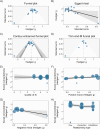Endogenous mu-opioid modulation of social connection in humans: a systematic review and meta-analysis
- PMID: 39289345
- PMCID: PMC11408506
- DOI: 10.1038/s41398-024-03088-3
Endogenous mu-opioid modulation of social connection in humans: a systematic review and meta-analysis
Abstract
Social bonding, essential for health and survival in all social species, depends on mu-opioid signalling in non-human mammals. A growing neuroimaging and psychopharmacology literature also implicates mu-opioids in human social connectedness. To determine the role of mu-opioids for social connectedness in healthy humans, we conducted a preregistered ( https://osf.io/x5wmq ) multilevel random-effects meta-analysis of randomised double-blind placebo-controlled opioid antagonist studies. We included data from 8 publications and 2 unpublished projects, totalling 17 outcomes (N = 455) sourced from a final literature search in Web of Science, Scopus, PubMed and EMBASE on October 12, 2023, and through community contributions. All studies used naltrexone (25-100 mg) to block the mu-opioid system and measured social connectedness by self-report. Opioid antagonism slightly reduced feelings of social connectedness (Hedges' g [95% CI) = -0.20] [-0.32, -0.07]. Results were highly consistent within and between studies (I2 = 23%). However, there was some indication of bias in favour of larger effects among smaller studies (Egger's test: B = -2.16, SE = 0.93, z = -2.33, p = 0.02), and publication bias analysis indicated that the effect of naltrexone might be overestimated. The results clearly demonstrate that intact mu-opioid signalling is not essential for experiencing social connectedness, as robust feelings of connectedness are evident even during full pharmacological mu-opioid blockade. Nevertheless, antagonism reduced measures of social connection, consistent with a modulatory role of mu-opioids for human social connectedness. The modest effect size relative to findings in non-human animals, could be related to differences in measurement (subjective human responses versus behavioural/motivation indices in animals), species specific neural mechanisms, or naltrexone effects on other opioid receptor subtypes. In sum, these results help explain how mu-opioid dysregulation and social disconnection can contribute to disability, and conversely-how social connection can buffer risk of ill health.
© 2024. The Author(s).
Conflict of interest statement
The authors declare no competing interests.
Figures


Similar articles
-
Opioids and social bonding: naltrexone reduces feelings of social connection.Soc Cogn Affect Neurosci. 2016 May;11(5):728-35. doi: 10.1093/scan/nsw006. Epub 2016 Jan 21. Soc Cogn Affect Neurosci. 2016. PMID: 26796966 Free PMC article. Clinical Trial.
-
Chronic treatment with the opioid antagonist naltrexone favours the coupling of spinal cord μ-opioid receptors to Gαz protein subunits.Neuropharmacology. 2012 Feb;62(2):757-64. doi: 10.1016/j.neuropharm.2011.08.029. Epub 2011 Aug 31. Neuropharmacology. 2012. PMID: 21903117
-
Opioid receptor blockade inhibits self-disclosure during a closeness-building social interaction.Psychoneuroendocrinology. 2020 Mar;113:104559. doi: 10.1016/j.psyneuen.2019.104559. Epub 2019 Dec 20. Psychoneuroendocrinology. 2020. PMID: 31911348 Clinical Trial.
-
Efficacy of Treatments for Opioid-Induced Constipation: Systematic Review and Meta-analysis.Clin Gastroenterol Hepatol. 2018 Oct;16(10):1569-1584.e2. doi: 10.1016/j.cgh.2018.01.021. Epub 2018 Jan 31. Clin Gastroenterol Hepatol. 2018. PMID: 29374616
-
Nalmefene for the management of alcohol dependence: review on its pharmacology, mechanism of action and meta-analysis on its clinical efficacy.Eur Neuropsychopharmacol. 2016 Dec;26(12):1941-1949. doi: 10.1016/j.euroneuro.2016.10.008. Epub 2016 Nov 12. Eur Neuropsychopharmacol. 2016. PMID: 27842940 Review.
References
Publication types
MeSH terms
Substances
Grants and funding
- 802885/EC | EU Framework Programme for Research and Innovation H2020 | H2020 Excellent Science (H2020 Priority Excellent Science)
- 802885/EC | EU Framework Programme for Research and Innovation H2020 | H2020 Excellent Science (H2020 Priority Excellent Science)
- 802885/EC | EU Framework Programme for Research and Innovation H2020 | H2020 Excellent Science (H2020 Priority Excellent Science)
LinkOut - more resources
Full Text Sources
Research Materials

